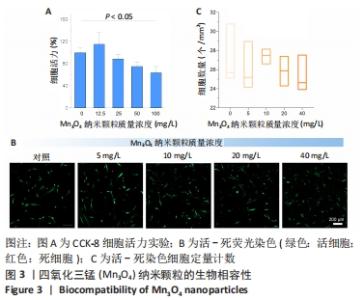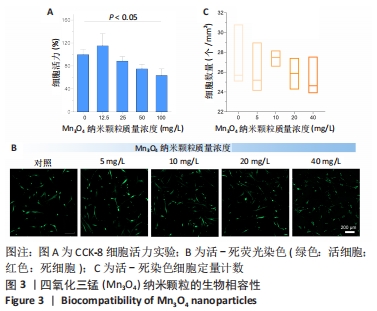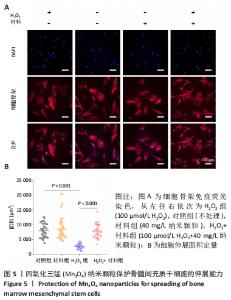Chinese Journal of Tissue Engineering Research ›› 2023, Vol. 27 ›› Issue (6): 821-826.doi: 10.12307/2023.230
Protection of manganese oxide nanoparticles for bone marrow mesenchymal stem cell spreading against oxidative stress
Tian Qinyu1, 2, Tian Xinggui3, Tian Zhuang4, Sui Xiang2, Liu Shuyun2, Lu Xiaobo1, Guo Quanyi1, 2
- 1Department of Bone and Joint Surgery, Affiliated Hospital of Southwest Medical University, Luzhou 646000, Sichuan Province, China; 2Institute of Orthopedics, First Medical Center, Chinese PLA General Hospital, Beijing Key Lab of Regenerative Medicine in Orthopedics, Beijing 100853, China; 3University Center of Orthopaedic, Trauma and Plastic Surgery, University Hospital Carl Gustav Carus at Technische Universität Dresden, Dresden 01307, Germany; 4Ninth Clinical School of Peking University, Beijing Shijitan Hospital, Beijing 100038, China
-
Received:2022-01-14Accepted:2022-03-17Online:2023-02-28Published:2022-08-04 -
Contact:Guo Quanyi, MD, Professor, Chief physician, Department of Bone and Joint Surgery, Affiliated Hospital of Southwest Medical University, Luzhou 646000, Sichuan Province, China; Institute of Orthopedics, First Medical Center, Chinese PLA General Hospital, Beijing Key Lab of Regenerative Medicine in Orthopedics, Key Laboratory of Musculoskeletal Trauma & War Injuries, PLA, Beijing 100853, China -
About author:Tian Qinyu, Master candidate, Department of Bone and Joint Surgery, Affiliated Hospital of Southwest Medical University, Luzhou 646000, Sichuan Province, China; Institute of Orthopedics, First Medical Center, Chinese PLA General Hospital, Beijing Key Lab of Regenerative Medicine in Orthopedics, Key Laboratory of Musculoskeletal Trauma & War Injuries, PLA, Beijing 100853, China -
Supported by:the National Key Research and Development Plan Project, No. 2019YFA0110600 (to GQY)
CLC Number:
Cite this article
Tian Qinyu, Tian Xinggui, Tian Zhuang, Sui Xiang, Liu Shuyun, Lu Xiaobo, Guo Quanyi. Protection of manganese oxide nanoparticles for bone marrow mesenchymal stem cell spreading against oxidative stress[J]. Chinese Journal of Tissue Engineering Research, 2023, 27(6): 821-826.
share this article
Add to citation manager EndNote|Reference Manager|ProCite|BibTeX|RefWorks
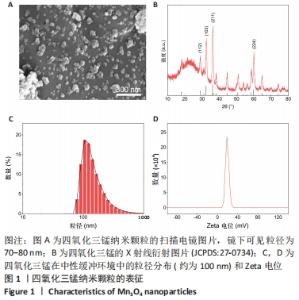
2.1 Mn3O4纳米颗粒形貌及结构 扫描电镜观察显示:制备的颗粒在镜下呈均匀分散的状态,为纳米级,直径为70- 80 nm,见图1A。经X射线衍射测试得出的结果与物质标准卡片(JCPDS:27-0734)对比后发现,该物质与Mn3O4的晶体结构一致,见图1B。 2.2 Mn3O4纳米颗粒粒径及Zeta电位表征 为检测Mn3O4纳米颗粒在人体环境中的存在状态,将其分散在PBS中,并使用粒径电位仪检测。由图1C可知,在缓冲液环境中,动态光散射显示纳米颗粒的流体动力学粒径主要集中于100 nm,比镜下实际粒径稍大;Zeta电位值约为+20 mV,证明该纳米颗粒可在PBS溶液中以较稳定的分散状态存在,不易团聚,见图1D。"
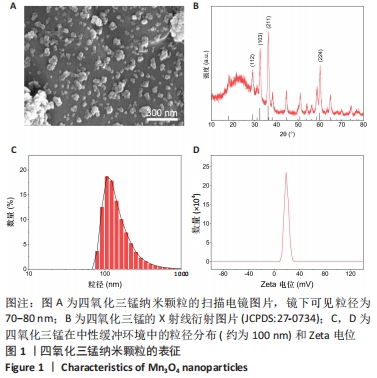
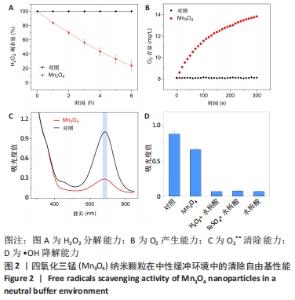
2.3 Mn3O4纳米颗粒清除自由基性能测试结果 为检测纳米颗粒的过氧化氢酶样酶活性,进行了H2O2分解和O2产生实验。如图2A所示,在纳米颗粒存在下,溶液中的H2O2随时间增加而减少,在6 h时H2O2的剩余量仅剩约20%,并且溶液在分解H2O2的同时产生了O2,见图2B,说明该纳米颗粒具有一定的过氧化氢酶样酶活性,且能够在较短的时间内使H2O2完全清除。通过检测材料的超氧化物歧化酶样性能,见图2C,即O2.-清除能力,发现加入纳米颗粒的溶液吸光度迅速减少,在680 nm处的吸光度值仅有约0.3(对照组约为1.05),证明该颗粒具有较好的超氧化物歧化酶样活性。除此之外,还测试了纳米颗粒的.OH清除能力,见图2D,发现该颗粒能够使溶液的吸光度下降,说明其也具有一定的.OH清除性能。"

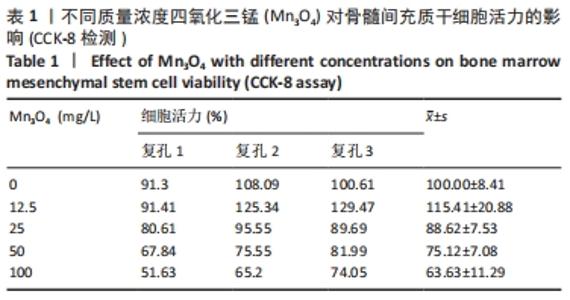
2.4 Mn3O4纳米颗粒的细胞生物相容性实验 为保证纳米颗粒能够安全的用于间充质干细胞,使用CCK-8实验检测了不同质量浓度Mn3O4纳米颗粒(0,12.5,25,50,100 mg/L)对细胞活力的影响,见表1,图3A,该材料在质量浓度为50 mg/L以内对细胞活力无明显影响,并且无统计学差异,在100 mg/L时细胞活力降低(P < 0.05)。由于该材料为棕色颗粒,可能会导致CCK-8吸光度值结果误差,参考细胞活力检测结果,使用了小于50 mg/L的不同梯度的质量浓度(0,5,10,20,40 mg/L)对材料的细胞毒性进行进一步检测。活-死染色结果显示,荧光成像中未见明显死细胞,并且细胞计数结果表明各组间细胞数量无明显差异,见图3B,C,证明该纳米材料在40 mg/L范围内不会导致明显的细胞死亡。"
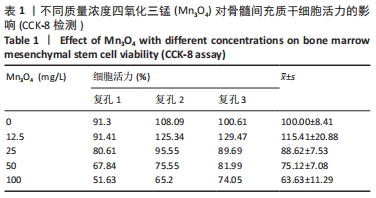
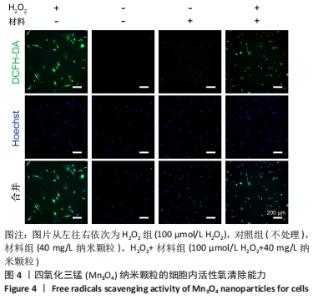
2.5 Mn3O4纳米颗粒在细胞环境内活性氧清除性能测试结果 使用H2O2诱导细胞氧化应激,即在培养基中加入100 μmol/L H2O2,并将细胞分为对照组(不处理),H2O2组(100 μmol/L H2O2),材料组(40 mg/L Mn3O4纳米颗粒),H2O2+材料组(100 μmol/L H2O2+40 mg/L Mn3O4纳米颗粒)。由荧光图片可以看出,单纯H2O2处理组有大量的荧光产生,说明H2O2成功诱导了细胞内氧化应激发生;H2O2+材料组的细胞检测出一定量的荧光,但是强度相对于H2O2组有明显减低,说明该组活性氧量较H2O2组低,并且从材料组可以看出该材料的加入不会诱导细胞内活性氧的产生,见图4。"
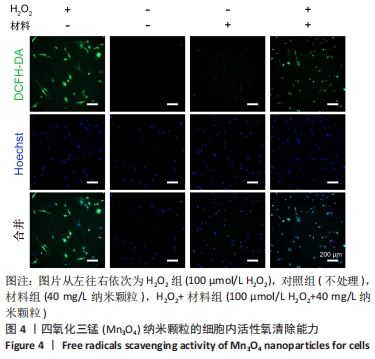
| [1] NATHAN C, CUNNINGHAM-BUSSEL A. Beyond oxidative stress: an immunologist’s guide to reactive oxygen species. Nat Rev Immunol. 2013; 13(5):349-361. [2] FINKEL T, HOLBROOK NJ. Oxidants, oxidative stress and the biology of ageing. Nature. 2000;408(6809):239-247. [3] GHORBANI M, DERAKHSHANKHAH H, JAFARI S, et al. Nanozyme antioxidants as emerging alternatives for natural antioxidants: Achievements and challenges in perspective. Nano Today. 2019;29:100775-100781. [4] IMLAY JA, LINN S. DNA damage and oxygen radical toxicity. Science. 1988; 240(4857):1302-1309. [5] YANG B, CHEN Y, SHI J. Reactive Oxygen Species (ROS)-Based Nanomedicine. Chem Rev. 2019;119(8):4881-4985. [6] VALLE-PRIETO A, CONGET PA. Human mesenchymal stem cells efficiently manage oxidative stress. Stem Cells Dev. 2010;19(12):1885-1893. [7] ZVIBEL I, SMETS F, SORIANO H. Anoikis: roadblock to cell transplantation? Cell Transplant. 2002;11(7):621-630. [8] MATHIEU PS, LOBOA EG. Cytoskeletal and focal adhesion influences on mesenchymal stem cell shape, mechanical properties, and differentiation down osteogenic, adipogenic, and chondrogenic pathways. Tissue Eng Part B Rev. 2012;18(6):436-444. [9] DENU RA, HEMATTI P. Effects of Oxidative Stress on Mesenchymal Stem Cell Biology. Oxid Med Cell Longev. 2016;2016:2989076. [10] SONG H, CHA MJ, SONG BW, et al. Reactive oxygen species inhibit adhesion of mesenchymal stem cells implanted into ischemic myocardium via interference of focal adhesion complex. Stem Cells. 2010;28(3):555-563. [11] FRAISL P, ARAGONÉS J, CARMELIET P. Inhibition of oxygen sensors as a therapeutic strategy for ischaemic and inflammatory disease. Nat Rev Drug Discov. 2009;8(2):139-152. [12] WU J, WANG X, WANG Q, et al. Nanomaterials with enzyme-like characteristics (nanozymes): next-generation artificial enzymes (II). Chem Soc Rev. 2019;48(4):1004-1076. [13] WANG L, ZHU B, DENG Y, et al. Biocatalytic and Antioxidant Nanostructures for ROS Scavenging and Biotherapeutics. Adv Funct Mater. 2021;31(31): 2170226. [14] HUANG Y, REN J, QU X. Nanozymes: Classification, Catalytic Mechanisms, Activity Regulation, and Applications. Chem Rev. 2019;119(6):4357-4412. [15] JI S, JIANG B, HAO H, et al. Matching the kinetics of natural enzymes with a single-atom iron nanozyme. Nature Catalysis. 2021;4(5):407-417. [16] JIANG D, NI D, ROSENKRANS ZT, et al. Nanozyme: new horizons for responsive biomedical applications. Chem Soc Rev. 2019;48(14):3683-3704. [17] YANG W, YANG X, ZHU L, et al. Nanozymes: Activity origin, catalytic mechanism, and biological application. Coordination Chemistry Reviews. 2021;448:214170. [18] HUANG G, ZANG J, HE L, et al. Bioactive Nanoenzyme Reverses Oxidative Damage and Endoplasmic Reticulum Stress in Neurons under Ischemic Stroke. ACS Nano. 2021;16(1):431-452. [19] SHI J, YU W, XU L, et al. Bioinspired Nanosponge for Salvaging Ischemic Stroke via Free Radical Scavenging and Self-Adapted Oxygen Regulating. Nano Lett. 2020;20(1):780-789. [20] JIANG X, GRAY P, PATEL M, et al. Crossover between anti- and pro-oxidant activities of different manganese oxide nanoparticles and their biological implications. J Mater Chem B. 2020;8(6):1191-1201. [21] ZHANG S, LI H, WU Z, et al. Effects of Co doping on the structure and physicochemical properties of hausmannite (Mn3O4) and its transformation during aging. Chemical Geology. 2021;582:120448. [22] CHENG Y, CHENG C, YAO J, et al. Mn3O4 Nanozyme for Inflammatory Bowel Disease Therapy. Advanced Therapeutics. 2021; 4(9):2100081-2100090. [23] DING B, ZHENG P, MA P, et al. Manganese Oxide Nanomaterials: Synthesis, Properties, and Theranostic Applications. Adv Mater. 2020;32(10):e1905823. [24] QIAN X, HAN X, YU L, et al. Manganese‐Based Functional Nanoplatforms: Nanosynthetic Construction, Physiochemical Property, and Theranostic Applicability. Adv Funct Mater. 2019;30(3):1907066. [25] HAN SI, LEE SW, CHO MG, et al. Epitaxially Strained CeO2/Mn3O4 Nanocrystals as an Enhanced Antioxidant for Radioprotection. Adv Mater. 2020;32(31):2001566. [26] TAYLOR KM, RIETER WJ, LIN W. Manganese-based nanoscale metal-organic frameworks for magnetic resonance imaging. J Am Chem Soc. 2008;130(44): 14358-14359. [27] YAO J, CHENG Y, ZHOU M, et al. ROS scavenging Mn3O4 nanozymes for in vivo anti-inflammation. Chem Sci. 2018;9(11):2927-2933. [28] WANG Y, CAI R, CHEN C. The Nano-Bio Interactions of Nanomedicines: Understanding the Biochemical Driving Forces and Redox Reactions. Acc Chem Res. 2019;52(6):1507-1518. [29] DING J, YAO Y, LI J, et al. A Reactive Oxygen Species Scavenging and O2 Generating Injectable Hydrogel for Myocardial Infarction Treatment In vivo. Small. 2020;16(48):e2005038. [30] TANG Z, ZHAO P, WANG H, et al. Biomedicine Meets Fenton Chemistry. Chem Rev. 2021;121(4):1981-2019. [31] VARSOU DD, AFANTITIS A, TSOUMANIS A, et al. Zeta-Potential Read-Across Model Utilizing Nanodescriptors Extracted via the NanoXtract Image Analysis Tool Available on the Enalos Nanoinformatics Cloud Platform. Small. 2020;16(21):e1906588. [32] PREMA P, NGUYEN VH, VENKATACHALAM K, et al. Hexavalent chromium removal from aqueous solutions using biogenic iron nanoparticles: Kinetics and equilibrium study. Environ Res. 2022;205:112477. [33] ABDEL-RASHID RS, HELAL DA, ALAA-ELDIN AA, et al. Polymeric versus lipid nanocapsules for miconazole nitrate enhanced topical delivery: in vitro and ex vivo evaluation. Drug Deliv. 2022;29(1):294-304. [34] XU Z, QU A, WANG W, et al. Facet-Dependent Biodegradable Mn3O4 Nanoparticles for Ameliorating Parkinson’s Disease. Adv Healthc Mater. 2021;10(23):e2101316. [35] BARATI S, MOVAHEDIN M. The Antioxidant Effects of Calligonum Extract on Oxidative Stress in Spermatogonial Stem Cells Culture. Pharmaceutical Sciences. 2021;27(4):521-527. [36] IM GB, KIM YG, JO IS, et al. Effect of polystyrene nanoplastics and their degraded forms on stem cell fate. J Hazard Mater. 2022;430:128411. [37] SHOU JW, LI XX, TANG YS, et al. Novel mechanistic insight on the neuroprotective effect of berberine: The role of PPARδ for antioxidant action. Free Radic Biol Med. 2022;181:62-71. [38] KURIAN AG, SINGH RK, LEE JH, et al. Surface-Engineered Hybrid Gelatin Methacryloyl with Nanoceria as Reactive Oxygen Species Responsive Matrixes for Bone Therapeutics. ACS Appl Bio Mater. 2022 Feb 22. doi: 10.1021/acsabm.1c01189. [39] LEE S, LEE J, BYUN H, et al. Evaluation of the anti-oxidative and ROS scavenging properties of biomaterials coated with epigallocatechin gallate for tissue engineering. Acta Biomater. 2021;124:166-178. [40] HEMACHANDRA LP, SHIN DH, DIER U, et al. Mitochondrial Superoxide Dismutase Has a Protumorigenic Role in Ovarian Clear Cell Carcinoma. Cancer Res. 2015;75(22):4973-4984. [41] LIU YQ, MAO Y, XU E, et al. Nanozyme scavenging ROS for prevention of pathologic alpha-synuclein transmission in Parkinson’s disease. Nano Today. 2021;36:101027. [42] ZELLER KS, RIAZ A, SARVE H, et al. The role of mechanical force and ROS in integrin-dependent signals. PLoS One. 2013;8(5):e64897. [43] KANG DH, KANG SW. Targeting cellular antioxidant enzymes for treating atherosclerotic vascular disease. Biomol Ther (Seoul). 2013;21(2):89-96. |
| [1] | Gao Ting, Ma Xiaohong, Li Xiaorong. Extraction and identification of exosomes from three different sources of ovarian granulosa cells [J]. Chinese Journal of Tissue Engineering Research, 2023, 27(6): 860-865. |
| [2] | Li Rui, Liu Zhen, Guo Zige, Lu Ruijie, Wang Chen. Aspirin-loaded chitosan nanoparticles and polydopamine modified titanium sheets improve osteogenic differentiation [J]. Chinese Journal of Tissue Engineering Research, 2023, 27(3): 374-379. |
| [3] | Li Yue, Lyu Yan, Feng Wanying, Song Yang, Yan Yu, Guan Yongge. Preparation of hyperoside nanoparticles to repair endometrial injury [J]. Chinese Journal of Tissue Engineering Research, 2023, 27(3): 360-366. |
| [4] | Li Zhen, Liu Hongbao. Influencing factors and mechanism of nanoparticle renal targeting [J]. Chinese Journal of Tissue Engineering Research, 2023, 27(3): 453-460. |
| [5] | Ma Ziyu, Zhang Bin, Zhang Yuntao, Liu Xiaolin, Bian Zhihong, Qiao Luhui, Hou Yudong. Effects of quercetin sustained release system on osteogenic properties of MC3T3-E1 cells [J]. Chinese Journal of Tissue Engineering Research, 2023, 27(12): 1870-1876. |
| [6] | Ye Xuwen, Gu Yong, Chen Liang. Curcumin loaded injectable microspheres retard progression of intervertebral disc degeneration [J]. Chinese Journal of Tissue Engineering Research, 2023, 27(12): 1884-1891. |
| [7] | Hu Jinlong, Quan Huahong, Wang Jingcheng, Zhang Pei, Zhang Jiale, Chen Pengtao, Liang Yuan. Effect of copper sulfide nanoparticles loaded thermosensitive hydrogel Pluronic F127 on infected wound healing in rats [J]. Chinese Journal of Tissue Engineering Research, 2023, 27(12): 1927-1931. |
| [8] | Gan Tian, Wang Wenyuan, Yan Shujin, Hao Lan, Ran Haitao, Wang Zhigang, Xia Jizhu. Near infrared photoresponsive nanoparticles loaded with LXR agonists for photothermal immunotherapy [J]. Chinese Journal of Tissue Engineering Research, 2023, 27(12): 1863-1869. |
| [9] | Fu Chunmei, Zhang Pu, Wang Yang, Li Xiaolin, Xue Yan, Fu Jie, Zhang Cixian, Yang Yujuan, Duan Yaya, Feng Kai. Allogeneic hematopoietic stem cell transplantation in the treatment of 24 patients with severe aplastic anemia [J]. Chinese Journal of Tissue Engineering Research, 2023, 27(1): 15-20. |
| [10] | Huang Chuwen, Jiang Hua, Li Minqing. Complications and death causes of peripheral blood stem cell transplantation in the treatment of thalassemia major [J]. Chinese Journal of Tissue Engineering Research, 2023, 27(1): 42-48. |
| [11] | Li Zhiyi, He Pengcheng, Bian Tianyue, Xiao Yuxia, Gao Lu, Liu Huasheng. Bibliometric and visualized analysis of ferroptosis mechanism research [J]. Chinese Journal of Tissue Engineering Research, 2022, 26(8): 1202-1209. |
| [12] | Fang Xiaolei, Leng Jun, Zhang Chen, Liu Huimin, Guo Wen. Systematic evaluation of different therapeutic effects of mesenchymal stem cell transplantation in the treatment of ischemic stroke [J]. Chinese Journal of Tissue Engineering Research, 2022, 26(7): 1085-1092. |
| [13] | Cao Fei, Hui Min, Dong Xiling, Wang Le, Wang Zuxu, Zhang Min, Zhang Xiaoming, Liu Tongbin. Preparation of silver-loaded nanohydroxyapatite/polycaprolactone composite nanofiber scaffold and its osteogenic and antibacterial properties [J]. Chinese Journal of Tissue Engineering Research, 2022, 26(34): 5461-5467. |
| [14] | Wen Jianyun, Miao Lili, Guan Di, Liu Xuan, Chen Libai, Feng Xiaoqin, Xu Xiaoxiao, Liu Qiujun, Wu Xuedong, He Yuelin. Correlation of the level of plasma biomarkers with acute graft-versus-host disease in children [J]. Chinese Journal of Tissue Engineering Research, 2022, 26(31): 5032-5039. |
| [15] | Wu Haineng, Geng Kang, Wang Jing, Xiong Aibing. Platelet-rich fibrin combined with curcumin nanoparticle hydrogel promotes wound healing in diabetic mice [J]. Chinese Journal of Tissue Engineering Research, 2022, 26(27): 4300-4307. |
| Viewed | ||||||
|
Full text |
|
|||||
|
Abstract |
|
|||||
